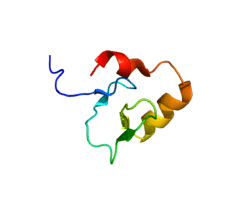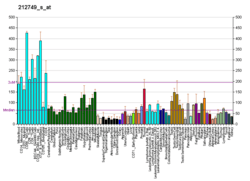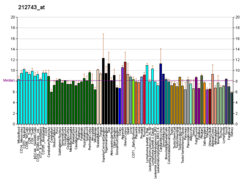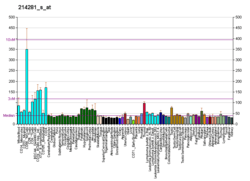RCHY1
RING finger and CHY zinc finger domain-containing protein 1 is a protein that in humans is encoded by the RCHY1 gene.[5]
Function
The protein encoded by this gene has ubiquitin-protein ligase activity. This protein binds with p53 and promotes the ubiquitin-mediated proteosomal degradation of p53. This gene is oncogenic because loss of p53 function contributes directly to malignant tumor development. Transcription of this gene is regulated by p53. Alternative splicing results in multiple transcript variants encoding different isoforms.[5]
Interactions
RCHY1 has been shown to interact with P53[6][7] and Androgen receptor.[8]
References
- 1 2 3 GRCh38: Ensembl release 89: ENSG00000163743 - Ensembl, May 2017
- 1 2 3 GRCm38: Ensembl release 89: ENSMUSG00000029397 - Ensembl, May 2017
- ↑ "Human PubMed Reference:".
- ↑ "Mouse PubMed Reference:".
- 1 2 "Entrez Gene: RCHY1 ring finger and CHY zinc finger domain containing 1".
- ↑ Leng RP, Lin Y, Ma W, Wu H, Lemmers B, Chung S, Parant JM, Lozano G, Hakem R, Benchimol S (Mar 2003). "Pirh2, a p53-induced ubiquitin-protein ligase, promotes p53 degradation". Cell. 112 (6): 779–91. doi:10.1016/S0092-8674(03)00193-4. PMID 12654245.
- ↑ Sheng Y, Laister RC, Lemak A, Wu B, Tai E, Duan S, Lukin J, Sunnerhagen M, Srisailam S, Karra M, Benchimol S, Arrowsmith CH (Dec 2008). "Molecular basis of Pirh2-mediated p53 ubiquitylation". Nature Structural & Molecular Biology. 15 (12): 1334–42. doi:10.1038/nsmb.1521. PMC 4075976. PMID 19043414.
- ↑ Beitel LK, Elhaji YA, Lumbroso R, Wing SS, Panet-Raymond V, Gottlieb B, Pinsky L, Trifiro MA (Aug 2002). "Cloning and characterization of an androgen receptor N-terminal-interacting protein with ubiquitin-protein ligase activity". Journal of Molecular Endocrinology. 29 (1): 41–60. doi:10.1677/jme.0.0290041. PMID 12200228.
Further reading
- Bonaldo MF, Lennon G, Soares MB (Sep 1996). "Normalization and subtraction: two approaches to facilitate gene discovery". Genome Research. 6 (9): 791–806. doi:10.1101/gr.6.9.791. PMID 8889548.
- Beitel LK, Elhaji YA, Lumbroso R, Wing SS, Panet-Raymond V, Gottlieb B, Pinsky L, Trifiro MA (Aug 2002). "Cloning and characterization of an androgen receptor N-terminal-interacting protein with ubiquitin-protein ligase activity". Journal of Molecular Endocrinology. 29 (1): 41–60. doi:10.1677/jme.0.0290041. PMID 12200228.
- Leng RP, Lin Y, Ma W, Wu H, Lemmers B, Chung S, Parant JM, Lozano G, Hakem R, Benchimol S (Mar 2003). "Pirh2, a p53-induced ubiquitin-protein ligase, promotes p53 degradation". Cell. 112 (6): 779–91. doi:10.1016/S0092-8674(03)00193-4. PMID 12654245.
- Logan IR, Sapountzi V, Gaughan L, Neal DE, Robson CN (Mar 2004). "Control of human PIRH2 protein stability: involvement of TIP60 and the proteosome". The Journal of Biological Chemistry. 279 (12): 11696–704. doi:10.1074/jbc.M312712200. PMID 14701804.
- Corcoran CA, Huang Y, Sheikh MS (Aug 2004). "The p53 paddy wagon: COP1, Pirh2 and MDM2 are found resisting apoptosis and growth arrest". Cancer Biology & Therapy. 3 (8): 721–5. doi:10.4161/cbt.3.8.1068. PMID 15280670.
- Duan W, Gao L, Druhan LJ, Zhu WG, Morrison C, Otterson GA, Villalona-Calero MA (Nov 2004). "Expression of Pirh2, a newly identified ubiquitin protein ligase, in lung cancer". Journal of the National Cancer Institute. 96 (22): 1718–21. doi:10.1093/jnci/djh292. PMID 15547185.
- Zhang L, Li J, Wang C, Ma Y, Huo K (Apr 2005). "A new human gene hNTKL-BP1 interacts with hPirh2". Biochemical and Biophysical Research Communications. 330 (1): 293–7. doi:10.1016/j.bbrc.2005.02.156. PMID 15781263.
- Logan IR, Gaughan L, McCracken SR, Sapountzi V, Leung HY, Robson CN (Sep 2006). "Human PIRH2 enhances androgen receptor signaling through inhibition of histone deacetylase 1 and is overexpressed in prostate cancer". Molecular and Cellular Biology. 26 (17): 6502–10. doi:10.1128/MCB.00147-06. PMC 1592843. PMID 16914734.
- Duan W, Gao L, Wu X, Zhang Y, Otterson GA, Villalona-Calero MA (Oct 2006). "Differential response between the p53 ubiquitin-protein ligases Pirh2 and MdM2 following DNA damage in human cancer cells". Experimental Cell Research. 312 (17): 3370–8. doi:10.1016/j.yexcr.2006.07.005. PMID 16934800.
- Duan S, Yao Z, Hou D, Wu Z, Zhu WG, Wu M (Jul 2007). "Phosphorylation of Pirh2 by calmodulin-dependent kinase II impairs its ability to ubiquitinate p53". The EMBO Journal. 26 (13): 3062–74. doi:10.1038/sj.emboj.7601749. PMC 1914097. PMID 17568776.
- Hattori T, Isobe T, Abe K, Kikuchi H, Kitagawa K, Oda T, Uchida C, Kitagawa M (Nov 2007). "Pirh2 promotes ubiquitin-dependent degradation of the cyclin-dependent kinase inhibitor p27Kip1". Cancer Research. 67 (22): 10789–95. doi:10.1158/0008-5472.CAN-07-2033. PMID 18006823.
This article is issued from
Wikipedia.
The text is licensed under Creative Commons - Attribution - Sharealike.
Additional terms may apply for the media files.







